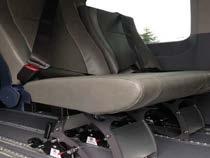
5 minute read
Guest Feature: An Often Overlooked Problem
from January—March 2021
by NMEDA
GUEST FEATURE
An Often Overlooked Problem
Advertisement
By Chris Woods
SENIOR PARTNER, FORTRESS PARTNERS INSURANCE AGENCY
A few months ago during a QAP committee meeting, we started a conversation about the physical damage value of your customer’s vehicles. It became apparent that we should discuss this in more detail. NMEDA and the QAP have done a great job in helping dealerships set up adequate limits and risk management procedures to protect the dealers in the event of liability claims that can cripple a business, but I want to talk about the physical damage coverage side. As the typical physical damage value of a singular vehicle usually ranges anywhere from $10,000 to $80,000, we realize these losses are not catastrophic, but still painful no matter how large or small your business.
I could expand on many different options and claim scenarios. All very exciting stuff. But I want to make each dealer aware of a potential coverage gap that could leave a bad impression in your customer’s mind. Do you know how and when your customer’s vehicles are covered when being worked on at another place of business? I’m going to take the next few minutes to explain and provide a little guidance on what your exposure is and how to best protect yourself and your customer. chose a limit of only $50,000 because he thought nothing would happen to more than one vehicle.
As your customer is not receiving any calls back from Friendly’s Body Shop, it has become apparent to your customer that Friendly’s does not have adequate GarageKeepers coverage to provide him money for his converted van. So Mr. Q presses on you to reimburse him for the van. You then submit the claim to your insurance carrier. Your claim adjuster notifies you that the van was not in your care, custody, or control when it was destroyed and therefore is not covered by your policy. You now must notify Mr. Q that he has to make a claim on his own auto insurance policy, which makes him very irate and you lose a customer.
How quickly this easy little project and vehicle repair became a major pain and a potential financial loss. All this can and should be avoided with a few smart risk management techniques.
When and how is your customer’s vehicle covered for physical damage?
Often I hear from the dealership:
“I’m sure it is covered. The body shop has an insurance policy.”
“Great, how do you know?”
“Well, I don’t…but they are in business and they have coverage, I’m sure.”
Here is the scenario for today: Mr. Q brings his Caravan back to you to have some updates done to his conversion. At that time you discuss the minor fender damage he has agreed to have repaired. You don’t have the capabilities to do the vehicle body work so you send the vehicle over to Friendly’s Body Shop, which you have done numerous times before. While sitting overnight at Friendly’s, lightning strikes the building causing a fire. Mr. Q’s van, along with three other vehicles belonging to customers of Friendly’s, are all destroyed.
You are notified the next day and you in turn call your customer. Not a great day, but you “know” that Friendly’s has insurance and this should be covered with no problems. Well, that is where this scenario goes downhill fast. Friendly’s garage insurance policy has GarageKeepers coverage for customer vehicles on his premises, but Friendly’s was saving money and
Two Quick Steps for Each Business Tending to Your Customer’s Vehicles
Step One: Always—each year—collect a current certificate of insurance from businesses that do work for you. Ask to be listed as a certificate holder. For this scenario, the certificate of insurance shows that Friendly’s has GarageKeepers coverage and lists the limit. This is where a little knowledge will go a long way. While reviewing the certificate, you see that they only have a limit of $50,000 for GarageKeepers. You know that Friendly’s lot is full of vehicles every day. Is $50,000 enough to cover your customer’s vehicle plus all the others?
Step Two: Know the difference in GarageKeepers coverage types. This is important.
There are three options of coverage for GarageKeepers. They are Direct Primary, Direct Excess, and Legal Liability. The first option, Direct Primary, is the most expensive and provides the best coverage. Direct Excess and Legal Liability are more restrictive and subsequently less expensive. Here is a brief summary of all three:
1. Direct Primary: The insurance carrier will pay for damages to a customer’s auto while in the policyholder’s care, custody, or control regardless if the policyholder is legally liable. This option will provide the best protection for your customer.
2. Direct Excess: The insurance carrier will only pay for damages in excess of any amount collectible under the vehicle owner’s policy if the policyholder cannot be held legally liable.
3. Legal Liability: The insurance carrier will only pay for damages to a customer’s auto while in the policyholder’s care, custody, or control in which the policyholder is legally liable for the damages.
Policyholder negligence is an example of legal liability, such as causing a fire to the customer’s vehicle while welding on it. Knowing the difference of these three choices and what coverage Friendly’s has is very important. If Direct Primary is not provided and/or Friendly’s Garagekeepers limit is too low, your customer may have to turn a claim into their own insurance agent. Even worse, if your customer does not have physical damage coverage on their own insurance policy...they may file a suit against your business or Friendly’s.
Trust But Verify
The certificate of insurance you collected from Friendly’s won’t necessarily show if the policy is written on a Direct Primary, Direct Excess, or Legal Liability basis, but don’t you think a $50,000 van is worth a phone call to Friendly’s insurance agent? Trust but verify by calling Friendly’s insurance agent. This is a necessary practice to follow because unfortunately there are no insurance endorsements available to cover your customer’s vehicles while at another place of business.
Take the steps. Protect yourself better financially in the event of a singular vehicle physical damage loss and protect your customers. I’ve seen too many times when the customer’s vehicle is only covered on their own insurance policy and this can make for an angry customer. Also, remember to verify your own insurance policy. If you are a dealership and have GarageKeepers coverage, which option is your insurance policy providing? Is your own limit high enough?
What I wish for you to learn from this article is a simple way to better protect your dealership’s exposures in an often overlooked event and to help keep your customers from not experiencing an unexpected claim to their own insurance policy. Just remember to collect a copy of the certificate of insurance from those with whom you do business. It may seem obvious that they have coverage, but always verify. This helps you to create a better experience for both you and your customers.







